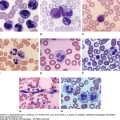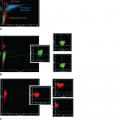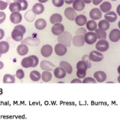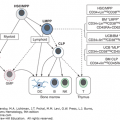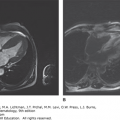INTRODUCTION
SUMMARY
The blood monocyte is in transit between the marrow and tissues where it transforms (matures) into a macrophage. In tissues, the monocyte develops a phenotype characteristic of the specific tissue of residence (e.g., Kupffer cells of liver, microglia of brain, osteoclasts of bone). Because the monocyte participates in virtually all inflammatory and immune reactions, its concentration in the blood may be increased in many such conditions, including autoimmune diseases, gastrointestinal disorders, sarcoidosis, and several viral and bacterial infections. Monocytosis, an increase in the blood absolute monocyte count to more than 800/μL (0.8 × 109/L), may occur in some patients with cancer and several unrelated conditions, such as postsplenectomy states, inflammatory bowel disease, and some chronic infections (e.g., bacterial endocarditis, tuberculosis, and brucellosis). The inconsistency and unpredictability in the blood monocyte concentration among patients with the same disease is a function of its relatively small blood pool size, the damping effect of a large tissue pool, its relatively long life span, the number and complexity of effectors in the relevant cytokine network that can influence the response, and the ability to expand macrophage numbers by local mitosis in tissues. The most striking increase in blood monocyte concentration occurs with hematopoietic malignancies, especially clonal monocytosis, and monocytic or myelomonocytic leukemia. Depression, myocardial infarction, parturition, thermal injuries, and marathon competition are closely associated with monocytosis. Table 70–1 is a comprehensive list of causes of monocytosis. Monocytopenia is notable in patients with aplastic anemia or hairy cell leukemia as a feature of pancytopenia. Although other cytopenias accompany the monocytopenia, the latter contributes significantly to the predisposition to infection and in hairy cell leukemia is an aid to diagnosis because of its constancy. The MonoMAC syndrome, the result of GATA2 mutations, is associated with extreme monocytopenia and amonocytosis.
|
The blood monocyte is a cell in transit from marrow to tissues.1 There are two major populations of blood monocytes based on physical properties: a smaller population thought to represent a less-mature stage, has a higher buoyant density, a smaller cell volume, lacks Fc receptors, and has greater tumoricidal activity; the larger population represents a more-mature stage, has a lower buoyant density, has a larger cell volume, displays Fc receptors, expresses more peroxidase activity, secretes larger amounts of interleukin (IL)-1, presents antigen, and mediates antibody-dependent cell-mediated cytotoxicity more efficiently. The larger population, classical monocytes that are highly phagocytic and proinflammatory, composes approximately 90 percent of blood monocytes, and strongly expresses CD14 (lipopolysaccharide receptor) but does not express CD16 (FcγRIII), designated the CD14++CD16− subset. These monocytes carry chemokine receptors CCR2hiCX3CR1lo. Of the remaining monocyte population, approximately 5 percent exhibit strong expression of CD14 and modest expression of CD16, the CD14++CD16+ “intermediate” subset, which expresses the chemokine receptors CCR2midCX3CR1hiCCR5mid, are proinflammatory and less phagocytic, and the “nonclassical” subset, which exhibits strong expression of CD16, the CD14+CD16++ subset, which expresses the chemokines CCRloCX3CR1hi, the so-called patrolling subset.2 The latter subset contains dendritic cell precursors.3 The major subsets can each be further stratified based on the expression of CD64 (FcγRI) (Chaps. 67 and 68).4
Acronyms and Abbreviations:
CD, cluster of differentiation; G-CSF, granulocyte colony-stimulating factor; GM-CSF, granulocyte-monocyte colony-stimulating factor; IL, interleukin; LPS, lipopolysaccharide; M-CSF, monocyte/macrophage colony-stimulating factor; MDS, myelodysplastic syndrome; MonoMAC, monocytopenia and Mycobacterium avium complex; NK, natural killer.
In tissues the monocyte is capable of transformation, under the influence of local environmental factors, into a macrophage. The monocyte plays an important role in acute and chronic inflammatory reactions, including granulomatous inflammation; immunologic reactions, including those involved in delayed hypersensitivity; tissue repair and reorganization; atheroma and thrombus formation; and the reaction to neoplasia and allografts. Because of the key role of monocytes in a variety of pathophysiologic reactions, a modest elevation in blood monocyte count can occur in many disparate conditions. In addition, in circumstances in which large increases in the number of macrophages are required in tissue sites, the demand may be met by local proliferation of macrophages and not be reflected either in an increased transit of monocytes through the blood compartment from marrow to tissue or in an increased concentration of blood monocytes.5 Occasionally, T-cell clones release only macrophage/monocyte colony-stimulating factor (M-CSF), which can stimulate the growth of macrophage colonies, providing a model for local control of macrophage proliferation.6
NORMAL BLOOD MONOCYTE CONCENTRATION
In the first 2 weeks of life, the average absolute blood monocyte count is approximately 1000/μL (1 × 109/L; Chap. 7). There is a gradual decline in the normal monocyte count to a mean of 400/μL (0.4 × 109/L) in adulthood, at which time monocytes constitute 1 to 9 percent (mean: 4 percent) of blood leukocytes (Chap. 2). Monocytosis is present when the absolute count exceeds 800/μL (0.8 × 109/L) in adults. Men tend to have slightly higher monocyte counts than women.7 Increments in the number of blood monocytes correlate directly with increases in the total blood monocyte pool and the monocyte turnover rate.8 The blood monocyte count cycles with a periodicity of 5 days.9 Older persons have a decrease in the proportion of CD14++CD16− to CD14+CD16+ monocytes as compared to younger persons, although the functional significance of this difference has not been established.10
DISORDERS ASSOCIATED WITH MONOCYTOSIS
Table 70–1 outlines the diseases reported to be associated with monocytosis. In one review, hematologic disorders represented more than 50 percent, collagen vascular diseases approximately 10 percent, and malignant disease approximately 8 percent of cases of monocytosis.11
Approximately 25 percent of patients with a myelodysplastic syndrome have an increase in the absolute monocyte count.12,13,14,15,16 Occasional patients with a myelodysplastic syndrome may develop an absolute monocyte count as high as 30,000/μL (30 × 109/L). Chronic monocytosis may be the principal feature of a clonal myeloid disease and precede by years the development of acute myelogenous leukemia. Patients with myelodysplasia and monocytosis have a high propensity to evolve into acute or chronic myelomonocytic leukemia. Monocytosis, as a feature of primary myelofibrosis, may be a harbinger of rapid progression.17 The number of promonocytes and monocytes in blood and marrow may be increased in patients with acute myelogenous leukemia of the monocytic18,19 or myelomonocytic type.20 Acute myelogenous leukemic cells with a histiocytic (macrophagic)21 or dendritic cell phenotype have been described.22,23,24 Patients with chronic myelomonocytic leukemia have, by definition, an increased absolute number of monocytes in the blood (≥1.0 × 109/L). The monocytosis may be more striking in some cases.25,26,27 Juvenile myelomonocytic leukemia, also, is defined in part by the increased number of monocytes in the blood and marrow.28 In some cases of acute monocytic leukemia, the monocytes are immature and have features of monoblasts or promonocytes, but in some cases they are indistinguishable by light microscopy from normal blood monocytes. Some automated instruments are dependent on the α-naphthol acetate esterase reaction to detect the proportion of monocytes in white cell differential counts. These instruments may underestimate leukemic monocytes counts, especially in cases of chronic myelomonocytic leukemia, because the leukemic monocytes have a decreased activity of the enzyme.25 An uncommon variant of Ph-positive chronic myelogenous leukemia (CML), expressing a p190 BCR-ABL transcript, is associated with a striking monocytosis in approximately 50 percent of cases.29,30
Monocytosis occurs in a number of neutropenic states: cyclic neutropenia,31 chronic granulocytopenia of childhood,32 familial benign chronic neutropenia,33 infantile genetic agranulocytosis34,35 and chronic hypoplastic neutropenia.36 In human cyclic neutropenia, monocyte oscillation is reciprocal to the neutrophil cycle; the peak monocytosis, which often exceeds 2000/μL (2.0 × 109/L), occurs at the end of the neutropenic period. Monocytes often stay above 500/μL (0.5 × 109/L) throughout the cycle. In the variety of other neutropenias mentioned, monocytopoiesis often is preserved in the face of neutropenia. Transient elevations of the monocyte count have been reported in the acute phases of drug-induced agranulocytosis.37,38,39 Monocytosis characteristically appears later in the recovery phase of agranulocytosis and may be a harbinger of recovery.37,40,41 Some observers dispute the validity of the latter observation.42
Monocytosis can occur with lymphomas and can increase with exacerbation of disease activity.43 Monocytosis has been noted in approximately 25 percent of cases of Hodgkin lymphoma, although it does not correlate with prognosis.43,44 In contrast, one treatise on the disease reports the hematologic values of patients with Hodgkin lymphoma at the time of diagnosis; only 4 of 100 have nominal increases in absolute blood monocyte counts.45 A statistically significant increase in blood monocyte concentration has been reported in myeloma and has been correlated with the presence of λ light-chain-containing monoclonal immunoglobulin.46,47 Rare cases of M-CSF secreting lymphoid tumors have been associated with monocytosis.48,49 Monocytosis at diagnosis has been correlated with decreased survival in several lymphoma types and chronic lymphocytic leukemia.50,51 Pseudolymphoma syndrome, induced by drugs such as carbamazepine, phenytoin, phenobarbital, and valproic acid, is associated with monocytosis.52
Stay updated, free articles. Join our Telegram channel

Full access? Get Clinical Tree


